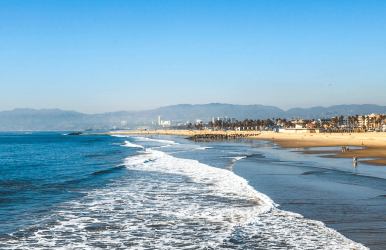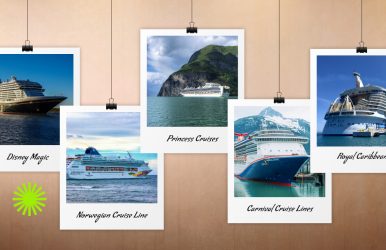Unique Things To Do In Venice Beach: Is Venice Beach LA Worth It?
BY Sibashree May 28, 2024
Picture yourself walking along the beach boardwalk, and suddenly, you bump into the likes of Leonardo DiCaprio, Scarlett Johansson, Robert Downey Jr, Julia Roberts, and Gwyneth Paltrow! This is Venice Beach in Los Angeles, your ultimate destination for “stargazing by the sea.” Now, with the boardwalk in Connecticut featuring in the list of the “USA TODAY 10 BEST Readers' Choice Awards,” many publications are claiming it to be a better alternative to Venice Beach. However, it is hard to replicate the charm of Venice Beach and its beautiful boardwalk, which are the icons of the culture and free spirit of California. Furthermore, with the fusion of food, creativity, and diversity, the beach and its boardwalk exude the most vibrant energy. However, they also allow you to relax with a sprinkle of quintessential Southern Californian good life. In this Tour and Travel Guide, we will mainly discuss why the boardwalk of Venice Beach is a must-see during a weekend getaway. However, we will also touch upon delightful electric bike rides in Santa Monica and the ultimate restaurant tour on Venice Beach. However, before everything else, let’s discuss the ideal time to plan a visit to Venice Beach. What Is The Best Time To Visit Venice Beach? Plan Your Trip Right Venice Beach in Los Angeles has a Mediterranean climate. The winters are mild and wet here, while summer is hot and humid. The shoulder seasons, fall and spring, are the ideal time for planning a coastal vacation to Venice Beach. Therefore, April to June and September to October are the best months to visit Venice Beach. Do you want to know more about the weather conditions in Venice Beach? Have a look at the table below. MonthHighest TemperatureLowest TemperatureDays of RainfallJanuary1995February20106March21125April24152May2516N/AJune2618N/AJuly3019N/AAugust3020N/ASeptember2919N/AOctober26171November24132December2194 Unique Things To Do In Venice Beach: Fun At The Boardwalk, Food And More California, despite bearing the brunt of the trade war between Canada and the USA, is leaving no stone unturned to welcome more Canadian tourists for beach vacations. And, of course, Venice Beach will be a prominent attraction for a facelift of beach tourism in Los Angeles and overall California. So, let’s find out what the Venice Beach Boardwalk offers, the food scene, and other outdoor attractions. 1. Venice Beach Boardwalk There is art everywhere on the Venice Beach Boardwalk! The Graffiti, murals, and, of course, the street performers make the place a living art gallery. Furthermore, painters are showing their genius, and acoustic guitar players are filling the air with their tunes. Also, suddenly, you are at Muscle Beach, which is known as the iconic backdrop of photoshoots for almost all the famous bodybuilders in the world. And you never know! You can even meet the athletes like Dustin Johnson, Ronda Rousey, and Serena Williams here. However, that’s not all! The Venice Beach Boardwalk shows the open-mindedness of California and its vibrant spirit. So, when you are in Venice Beach, soak in the atmosphere and… • Explore The Best Food Spots And Shops On Venice Beach Do you want to feel the soul of Venice in Los Angeles? Explore the shops on the Venice Beach boardwalk and grab the most adorable artistic creations, tie-dye t-shirts, leather items, and whatnot! Further, if you feel hungry while exploring the shops, you can enjoy a bite of the most delicious tacos, pizza, and fried churros. You can even walk to Abbot Kinney Boulevard, filled with new and trendy eating places. You will find vegan delicacies and gourmet dishes there. • Enjoy Surfing And Skateboarding: Unique Things To Do In Venice Beach If you are an adventurous soul, you cannot miss a visit to the Venice Skatepark. Surfing and skateboarding have been integral to California's culture. In fact, the Venice Skatepark has been a prominent ground for the “global skateboarding phenomenon” in a global landscape. Moreover, there are many surfing schools here, helping you to ride the waves and enjoy the serenity of the Pacific Ocean. • Indulge In The Beauty Of The Pacific Ocean How can you forget the beach itself when you are at Venice Beach? The wide and sandy beach is ideal for relaxing and soaking up the Sun. Furthermore, you can play volleyball on the beach, which looks magical when the Sun goes down. Also, the shades of pink and orange bathe the palm trees and the waves of the sea and make the entire place look like a postcard. Additionally, there are Venice canals near the boardwalk, and they will surely transport you to Italy. • Experience The Place As A Meeting Ground Of Different People And Different Perspectives The boardwalk of Venice Beach is like a giant fair. Here, you will find visitors, local people, musicians, painters, and everyone else meeting one another. Everyone here seems to enjoy a free spirit, regardless of where they come from. Do you want to know what holds for you in the future? You can ask fortune tellers and tarot card readers here. Overall, get ready for the quirkiest and most unique experience at Venice Beach. 2. Try The Best Food At These Restaurants In Venice Beach: Unique Things To Do In Venice Beach Did you think that Venice Beach was only about the Sun, beach, and skating? You were wrong! Felix Trattoria is the best restaurant on Venice Beach if you want to try authentic Italian cuisine. It serves the best pasta on the West Coast. It is located at 1023 Abbot Kinney Blvd, Venice, CA. Also, it remains open from 5-9 PM from Monday to Thursday and on Sunday. Moreover, from Friday to Saturday, it remains open between 5 and 9 PM. Gjelina is another great destination along Abbot Kinney for trying the best Cal-Italian delicacies. You must find a seat on the back patio for the ultimate delightful experience. It is located at 1429 Abbot Kinney Blvd, Venice, CA. It remains open from 8 AM to 10:30 PM. Other popular restaurants on Venice Beach are: RestaurantsAddressHours OpenSpecialtyAmerican Beauty425 Rose Avenue, Venice, CAMonday: 5:30–9 PMTuesday–Thursday: 5:30–10 PMFriday-Saturday: 5:30–11 PMSunday: 5:30–9 PMWoodfire steaksCompanion1700 Lincoln Boulevard, Venice, CAMonday-Tuesday: 7 AM –3 PMWednesday–Sunday: 7 AM–3 PM, 5–9 PMPizzasPastriesSandwichesSi! Mon60 N Venice Blvd, Venice, CAMonday–Thursday: 5–10 PMFriday and Saturday: 5 PM–MidnightSunday: 5–9 PMGluten-free fried chickenCrab Gaucho 3. Take An Electric Bike Tour Of Venice Beach And Santa Monica An electric bike tour with your core group in the morning or afternoon is one of the most unique things to do in Venice Beach. Be a part of a guided tour and learn about the history, especially of the place, from the commentary of local guides.














